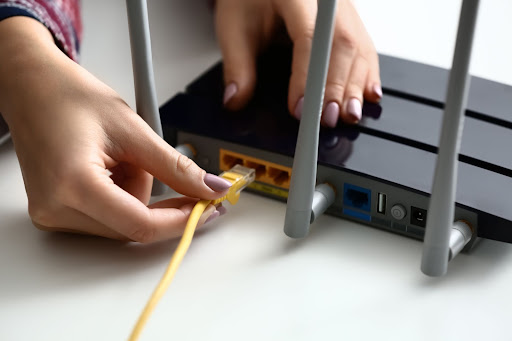Calls made over voice-over-internet-protocol (VoIP) can potentially degrade due to a data transmission error called packet loss. Common causes are faulty hardware, software bugs, and network attacks. There are plenty of ways to address packet loss, such as a system reboot, hardware upgrade, and software update. Below, we listed the steps on how to fix packet loss to ensure high-quality communications for your business.
1. Restart Your Devices
In smaller network environments, restarting your devices, such as computers, modems, and routers, gives them a chance to reset. It fixes minor glitches, releases memory space, and removes temporary files.
2. Inspect Networking Wires
Faulty networking wires like Ethernet cables cause packet loss if they are not connected properly, stretched too far, or placed under a heavy object. When this happens, data won’t be sent as efficiently. Perform a full inspection of your networking wires by making sure the Ethernet port is correctly plugged into the router and all cables are placed into their corresponding ports.

The Ethernet cable should be correctly plugged into the router to establish better connectivity.
3. Check Wi-Fi Signal
What causes packet loss in office environments are wireless connections like Wi-Fi. While it is a convenient way to connect to the internet, it can be a cause of packet loss due to the following factors:
- The Wi-Fi signal travels through thick walls
- Too many Wi-Fi-connected devices (router overload)
- A VoIP call is made farther from the source of the Wi-Fi signal
- Your office has multiple devices connected to Bluetooth
When the packets generated by VoIP encounter these interruptions, loss occurs. Switching to a wired Ethernet connection improves network performance since they are more stable than wireless connections. If the signal strength is still weak, follow these steps:
- Upgrade to Wi-Fi 6 or use a 5G connection
- Turning off Bluetooth devices or anything that causes static
- Reset the routers from time to time to clear any issues
- Install additional Wi-Fi routers or range extenders to increase the active range of your wireless networking signal
4. Replace Old Hardware
Packet loss occurs if you use old equipment when setting up a new VoIP system. These include your firewall, routers, Ethernet cables, and wires. Outdated hardware doesn’t have much capacity to handle modern networking technologies, while others get damaged due to everyday wear and tear, especially if they often get moved around.
Another hardware-based issue, like a duplex mismatch, is a common cause of packet loss. In telecommunications, a duplex allows two connected devices to send and receive information. Bottlenecks and network inefficiencies happen if the two devices work in different duplex modes.
Replacing old hardware prevents packet loss issues. Replace damaged wires to create a clearer connection path. When buying a new cable, check the jacket for durability and get a cable shield if you’re using multiple cables.
5. Configure Quality of Service (QoS) Settings
Setting up the QoS settings manages packet loss by sorting your network resources. This is especially useful if you want to devote more network traffic to resource-intensive data like voice and video. In case of network congestion, configure your QoS settings to prioritize voice and video traffic and enhance call quality.
6. Update Your Software
Software bugs are another potential cause of network issues. Regular software updates reduce the chances of bugs or glitches causing packet loss. To check if your software needs updating, check the task manager or activity monitor tool to see which apps are using a lot of bandwidth even when not in use. If software bugs still persist, upgrade to new, alternative software with fewer bugs.
7. Address Security Vulnerabilities
Sometimes, packet loss is caused by unscrupulous actors hampering your connection speed. Distributed Denial of Service (DDoS) floods a target network with large volumes of traffic, leading to an increase in packet loss. In a packet drop attack, the attacker takes control of your router and sends commands to drop packets to infiltrate your data streams.
If you suspect an attack, utilize an access control list (ACL) to block internet protocol (IP) addresses from outside the organization. This will stop the attack and allow the network traffic to return to normal. If the company’s security is at stake, consult a cybersecurity professional.
8. Increase Your Bandwidth
If packet loss continues to occur after taking the above steps, take a VoIP speed test to check if your connection has enough bandwidth for VoIP.
Bandwidth congestion occurs if a network can’t handle the high traffic volume, resulting in packet loss. This is because the packets sent out get lost in the stream as the entire office uses bandwidth. Consider increasing your bandwidth to support your VoIP service or choose a less congested time for VoIP calls. If bandwidth congestion is consistent, consider upgrading to a higher-speed network.
How Packet Loss Happens in VoIP Calls
VoIP sends calls over the internet by breaking down the audio from the call into data packets. A similar process is used with unified communications, where video data, chat, and shared files are converted into packets and transmitted. This form of conversion reduces the size of the overall data during transfer, and when it arrives, the data is unpacked.
For the most part, when data packets are transmitted, the most efficient path is taken so the recipient receives your voice data in short order. Unfortunately, for various reasons, voice and communications data might not arrive at your recipient as efficiently as it should. This is sometimes affected by factors like distance traveled and faulty hardware.
Regardless of the cause, poorly transmitted data packets affect call quality. When part of the data packet goes missing, pieces of the audio information sound garbled or may be missing entirely. In this case, a packet loss fix is required.
How to Prevent Packet Loss
Packet loss can happen for different reasons, but there are ways to prevent it. This could be anything from equipment upgrades and network monitoring to a hosted VoIP investment. Here are ways to prevent packet loss and ensure smoother network flow:
- Do regular network monitoring: A network performance monitor is an effective tool to identify the cause of packet loss. This allows you to take appropriate action to fix the issue. There are plenty of networking monitoring tools to choose from, like SolarWinds, Auvik, and NinjaOne.
- Optimize network settings: Network configuration is critical in reducing packet loss and improving network stability. The settings you apply and how data flows should be able to support your network demands.
- Invest in newer equipment: Upgrading to the latest network infrastructure ensures your devices are capable of handling modern traffic loads. They are equipped to avoid data loss and have a lower chance of introducing newer bugs into your network. Ideally, look for a router that allows bandwidth sharing and prioritizes voice and video packets.
- Find a reliable VoIP provider: Having a reliable and robust VoIP system is key to keeping your business communications running. While there are many options in the market, evaluate which one supports your business needs because not every provider produces the same call quality.

RingCentral lets you experience high-quality calls on the go. (Source: RingCentral)
When it comes to bulletproof reliability, RingCentral is the leading VoIP phone system, with its 99.999% uptime availability and secure global communications network. The RingCentral platform currently supports up to 10 billion minutes of voice traffic yearly and is designed to handle twice its capacity. Check out our RingCentral review to learn more about its enterprise-class business communications solution.
Frequently Asked Questions (FAQs)
VoIP data packets are units of audio data transmitted over the internet. In a VoIP call, voice samples are broken into small data packets for transmission over the IP network. Once the data packets are sent from the source, they will be reconstructed to enable the receiving end to hear the audio. The process continues in both directions until the call ends.
It is a specialized tool that provides a real-time view of network performance for comprehensive packet loss analysis. This lets you uncover the causes behind instances of packet loss and mitigate its effects. Packet monitoring software often includes an alert system for intermittent network problems.
VoIP uses UDP or TCP to send data. With UDP, when packets go missing, it’s usually because they arrive at the destination with errors or have been discarded along the way. At worst, a telephony session using UDP will terminate if there’s too much packet loss.
TCP prevents packet loss by constantly retransmitting data. When the data is sent a second time, the VoIP system picks up the lost packets and reconstructs the data stream. However, retransmission slows down the network if there are multiple calls experiencing packet loss.
Bottom Line
While dealing with packet loss can cause disruptions to your business, taking precautionary steps can save you from bigger headaches in the long run. That’s why learning how to fix packet loss is a necessary skill if you have a VoIP system in place. VoIP is particularly sensitive to network complications, so knowing the root cause allows your business to apply the right strategies without wasting resources.